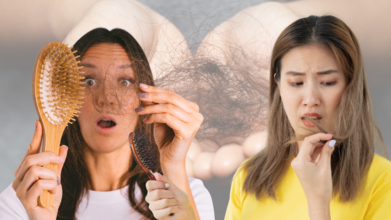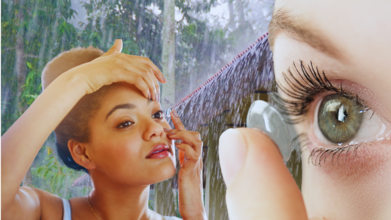- Health Conditions A-Z
- Health & Wellness
- Nutrition
- Fitness
- Health News
- Ayurveda
- Videos
- Medicine A-Z
- Parenting
- Web Stories
5 Proven Ways to Keep Dengue and Malaria at Bay This Season

Credits: Canva
While we are busy romanticising the rains, mosquitoes have already made their seasonal comeback. Dengue and malaria thrive during this time of year, and as the monsoon season brings much-needed relief from the summer heat, it also creates the perfect environment for the spread of mosquitoes, waterborne diseases, and skin infections.
Here are five tried-and-tested ways to keep dengue and malaria firmly at bay.
1. Clear Standing Water
Mosquitoes love existing in standing water. “Mosquitoes that spread dengue and malaria breed in standing water, even in tiny amounts like water in flowerpots, old tyres, buckets, or coolers,” explains Dr Rakesh Gupta. Which means that puddle on your balcony or that forgotten bucket in the corner could be a five-star mosquito maternity ward.
Both Dr Gupta and Dr Gowri Kulkarni agree on this as the most crucial preventive step. “Even the smallest pools of water, in flowerpots, discarded tyres, clogged drains, or air coolers, can serve as breeding grounds,” says Dr Kulkarni. The solution lies in a weekly routine check. Empty pet bowls, clean roof gutters, cover storage tanks, and if you have air coolers, dry them regularly. Your small efforts can literally break the mosquito life cycle.
2. Repel, Block, and Net Them Out
Mosquitoes prefer early mornings and late afternoons to feed on blood. Which is why repellents are not just optional; they are survival tools. Use creams, sprays, patches, or bands consistently.
“At night, always sleep under mosquito nets,” advises Dr Gupta. In fact, if you have babies or elderly family members, or if you are pregnant, nets become non-negotiable. Treated nets offer extra protection, so think of them as your double lock against intruders.
Dr Kulkarni adds that protection can be layered. “Prioritise protection from mosquitoes by using repellents, installing mosquito nets or screens, and wearing long-sleeved clothing during dawn and dusk when mosquito activity peaks.” Consider it your personal armour against the monsoon’s most persistent pests.
3. Cover Your Body
This season, ditch the mosquito-friendly wardrobe. Loose, long-sleeved shirts and full-length trousers are in; short sleeves and shorts are out. Mosquitoes love dark colours, so light shades are your best bet. Lighter clothes also keep you cooler in humid weather.
“If you can, tuck your shirt into your pants and your pants into your socks,” suggests Dr Gupta.
4. Clean Surroundings, Clear Conscience
A cluttered, damp home is practically an invitation for mosquitoes and skin infections to move in. “A clean and dry environment makes it harder for mosquitoes to breed,” says Dr Gupta. His advice is to keep kitchens tidy, avoid damp laundry lying around, and if you are using air coolers, empty and dry them often.
Dr Kulkarni emphasises the role of community action too. “Dengue and malaria prevention cannot be achieved in isolation. Coordinated neighbourhood clean-up drives, public awareness campaigns, and active involvement of local bodies make preventive efforts more effective and long-lasting.”
5. Boost Your Inner Defences
Of course, even the best mosquito-prevention tactics can fail if your immunity is running on low battery. Dr Gupta recommends a monsoon-friendly diet. “Eat plenty of seasonal fruits and vegetables, especially those with natural immunity-boosting properties like papaya, jamun, ginger, garlic, and turmeric.”
And do not forget the basics, like drinking only boiled or filtered water, skipping dubious street food, and washing fruits and vegetables thoroughly. After all, the last thing you want while dodging dengue is a waterborne stomach infection.
Do Not Ignore the Warning Signs
Despite your best efforts, if you develop a high fever, severe body aches, persistent headache, or unexplained fatigue, do not brush it off as ‘just the weather’. Dr Kulkarni cautions, “High fever, body aches, persistent headache, or unexplained fatigue should never be ignored during this season. Early medical advice can prevent complications and greatly improve recovery.”
Staying safe during the monsoon is all about balance. Enjoy the rains, but keep an eye on puddles. Relish the weather, but do not forget your mosquito repellent. As Dr Gupta sums it up, “Small preventive actions taken every day not only protect you but also help in keeping your community healthier through the season.”
Losing Too Much Hair? Dermatologists Expose the Hidden Trigger

Credits: Canva
Hair strands on your pillow, clogging your shower drain, or stuck in your hairbrush might feel like a daily tragedy. But experts say most hair fall cases aren’t permanent. With the right lifestyle tweaks, nutrition, and timely professional help, your hair can bounce back stronger.
How Stress Plays a Role
Stress doesn’t just give you headaches and sleepless nights; it also affects your hair follicles. Dr. Sarita Sanke, Senior Consultant Dermatology at Apollo Spectra Hospital, explains that stress can trigger a condition called telogen effluvium. “When the body undergoes stress, the hair follicles prematurely shift into the shedding phase, which usually shows up two to three months after the stressful event,” she says.
Hormones, Diet, and Other Responsible Factors
Hair fall rarely has just one cause. According to Pooja Nagdev, Cosmetologist and Founder of Inatur, “Factors like chronic stress, nutritional deficiencies, hormonal disturbances, and scalp infections can all worsen hair loss.” Even your hair care routine can betray you. Tight hairstyles, chemical-heavy treatments, or harsh shampoos can accelerate the problem.
And then there’s water. Yes, your water might be making your hair weak. Hard water or an imbalanced pH can damage the scalp and hair shafts, Nagdev warns. Using filtered water or a balancing rinse, like diluted apple cider vinegar, can help undo some of that hidden damage.
Feed Your Hair From Within
If your plate is lacking in key nutrients, your hair will show it before you do. Both experts emphasise that diet is the foundation of strong, healthy strands. Dr. Sanke recommends a nutrient-rich diet with “protein, iron, zinc, and vitamins, which are essential for healthy growth.”
Nagdev adds omega-3 fatty acids to the list and suggests loading up on eggs, nuts, green leafy vegetables, and lean proteins.
Scalp TLC: Gentle is the New Glam
We all love that salon-fresh blowout, but your hair might not. Excessive heat styling, chemical straightening, or tight ponytails can accelerate breakage. Instead, try a gentler approach.
Nagdev recommends scalp massage with nourishing oils such as coconut or rosemary oil, followed by mild, sulphate-free shampoos. Overwashing is another problem. Your scalp needs its natural oils to protect and strengthen the hair shaft.
“Gentle hair practices can reduce further damage,” says Dr. Sanke, stressing the importance of avoiding harsh treatments if you want your hair to stay resilient.
Relax Your Way to Regrowth
Cortisol, the stress hormone, doesn’t just mess with your mood. It also sabotages your scalp. “Lifestyle stress is a significant contributor to hair thinning,” Dr. Sanke points out.
Relaxation techniques like yoga, meditation, and even a simple daily walk can work wonders. Not only do they calm your mind, but they also improve circulation, which feeds your follicles. Nagdev reinforces that stress management isn’t optional. “High cortisol levels directly impact hair health. Stress reduction is one of the most underrated but most effective treatments,” she says.
When It’s Time to Call in the Pros
If you’ve tried dietary changes, scalp care, and stress management but your hair still refuses to cooperate, don’t despair. Professional treatments are constantly evolving.
Nagdev lists therapies like platelet-rich plasma (PRP), peptides, and low-level laser therapy as effective clinical interventions that encourage regrowth. These aren’t overnight fixes, though. Cosmetologists stress that consistency is crucial. “Visible results usually take 3–6 months of consistent care,” she says.
Mind and Body Together
Hair fall isn’t just a cosmetic issue; it often reflects what’s happening inside your body. Both experts agree that tackling it requires a holistic approach. From balanced nutrition and stress management to gentle care and medical treatments, there’s no one-size-fits-all solution.
As Dr. Sanke sums up, “With timely medical intervention, right nutrition, and healthy lifestyle practices, most cases of hair fall can be effectively managed and even reversed.” Nagdev says that hair fall isn’t permanent. With the right consistency and professional guidance, your hair can regain its strength and volume.
If You Do Not Have Diabetes, Should You Monitor Your Blood Sugar?

Credits: Canva
We love our gadgets. Smartwatches that count every step, rings that monitor our sleep, and apps that push us to drink water. Continuous glucose monitors (CGMs) have also slipped into the wellness scene, with promises of tracking your blood sugar in real time. While these devices were designed for people with diabetes, many wellness enthusiasts without the condition are strapping them on out of curiosity or in the hope of finding hidden clues about their health. However, the million-dollar question is, should you really be monitoring your blood sugar if you do not have diabetes?
The Rise of Glucose-Tracking as a Wellness Trend
Once upon a time, glucose monitors were found mostly in hospital wards and the bags of people with diabetes. Fast forward to now, and you will find tech entrepreneurs, athletes, and even your keto-following neighbour sporting one. They argue that blood sugar fluctuations reveal how your body reacts to different foods, stress, and sleep. Some influencers even post screenshots of their “sugar spikes” after a pizza binge, treating it like breaking news.
But experts caution that just because you can track it, does not mean you should. In healthy individuals, the body’s insulin system usually manages glucose efficiently. A temporary spike after a sweet is not necessarily a health crisis. In other words, do not panic if your numbers fluctuate after eating sweets.
When Curiosity Turns into Anxiety
Not all readings are accurate. CGMs and glucometers can sometimes misread, especially if sensors are not placed correctly or if you are dehydrated. A wrong number flashing on your screen can quickly send you spiralling. Imagine seeing a “high sugar” alert after a healthy lunch and immediately convincing yourself you are pre-diabetic. It will lead to frantic Google searches, unnecessary blood tests, and possibly swearing off rice forever.
Experts warn that false readings can create unnecessary anxiety and sometimes lead to people adopting restrictive diets without medical advice. This does more harm than good. So over-monitoring may not be the best idea.
The Consequences of Wrong Readings
Incorrect results do not just lead to worry; they can cause real consequences. Some people start experimenting with extreme low-carb diets, thinking they are ‘balancing’ their sugar. Others may pop supplements that promise better glucose control, even though they do not need them. In some cases, this self-diagnosis behaviour can mask actual health issues. For instance, fatigue might be due to anaemia or thyroid trouble, but a person obsessed with glucose data could blame “sugar spikes” instead, delaying proper diagnosis.
There are financial consequences also. CGMs can cost thousands a month.
Who Actually Needs to Monitor?
If you have been diagnosed with diabetes or prediabetes or have a high risk due to family history, blood sugar monitoring is a vital tool. It helps you understand how your lifestyle affects glucose and can guide treatment. Athletes sometimes use short-term glucose monitoring to see how their body responds to nutrition during training, but this is under professional guidance.
For the average healthy person, though, the body is usually well-equipped to manage sugar.
Smarter Alternatives for the Health-Conscious
If you are still itching for data, there are safer ways to monitor your wellness. Track your energy levels, quality of sleep, and digestion. Keep an eye on your waistline and blood pressure. And get regular blood tests during annual check-ups—these are far more reliable than daily glucose readings for the non-diabetic.
If you suspect trouble, consult a doctor. A simple fasting glucose or HbA1c test will give you accurate answers, minus the drama of continuous tracking.
Step Away from the Sensor
Glucose monitoring devices are lifesaving tools for people with diabetes. But for the average person, they may offer more confusion than clarity. A meal-induced sugar spike does not mean your health is doomed, and an unclear reading should not dictate your diet for the week. Unless your doctor recommends it, let your pancreas do its job.
Wearing Contact Lenses This Monsoon? Here Is What Eye Doctors Want You to Know

Credits: Canva
Monsoons are more than just good, hot food. And while most of us are quick to pull out umbrellas and raincoats, very few think about protecting our eyes, especially if we wear contact lenses. And according to eye specialists, this oversight could cost us more than just a little irritation.
Why Your Eyes Are at Risk in the Rainy Season
The humid climate during the rainy season creates the perfect environment for viruses to thrive. On top of that, people tend to spend more time indoors and in close contact with one another, which raises the risk of viral infections spreading by nearly 50 per cent. Add to this the common flu, which weakens immunity, and your eyes become more vulnerable than ever.
Contaminated water is another culprit. Dr Jayapratha Selvaraj, General Ophthalmology, points out that poor water hygiene can worsen eye conditions such as conjunctivitis (commonly known as pink eye) and keratitis, an infection of the cornea. “These infections are especially troublesome for people who wear contact lenses,” she says.
Dr Venkatesan C, Senior Consultant – Ophthalmology, agrees, adding that fungal and bacterial keratitis become more common during the monsoon. “They may start with redness, irritation, or pain, but if not treated right away, they can cause serious visual problems,” he warns.
Contact Lens and Monsoon
Contact lenses are a blessing for millions, particularly students and professionals who find glasses cumbersome. But during the monsoon, they can turn into little traps for germs.
“Contact lenses are safe if you follow the rules. But the moment hygiene slips, lenses can let bacteria or fungi stick to the eye’s surface,” says Dr Venkatesan. The moist, humid environment during the rainy season accelerates this risk. Tears dry more slowly in such weather, keeping the surface of the eye damp, a perfect breeding ground for infections.
Students, in particular, face greater danger. Many wear their lenses for long hours, share lens solutions with friends, or even swim in pools or rainwater while keeping their lenses on. Each of these habits, says Dr Venkatesan, can drastically raise the risk of infection.
Golden Rules of Lens Care in the Rainy Season
You do not have to abandon your lenses every time it rains. With the right care, you can enjoy both the rain and clear vision.
Dr Selvaraj lists the basics:
- Wash your hands thoroughly before touching or wearing lenses.
- Store lenses only in their designated case.
- Never use expired lenses.
- Avoid rinsing or storing lenses in tap water or saline; always use proper lens solution.
- Do not sleep, bath, or swim with lenses on.
Dr Venkatesan adds a few more monsoon must-dos:
- Always use fresh lens solution; never top up old liquid in the case.
- Take off your lenses before going out in the rain.
- If your doctor has not recommended it, do not sleep in your lenses.
- If you notice persistent redness, discharge, or blurred vision, remove your lenses immediately and see an eye doctor.
When Infections Happen
Despite best efforts, sometimes you still get infections. Viral conjunctivitis, for example, often resolves on its own, but that does not mean you should ignore it. “Ophthalmologists may prescribe antibiotic and lubricant eye drops to reduce discomfort and prevent spread,” explains Dr Selvaraj.
If the cornea gets involved, as in keratoconjunctivitis, timely medical treatment becomes crucial. Viral eye infections can remain contagious for up to two weeks, so doctors urge patients to:
- Wash hands frequently.
- Avoid sharing towels, bed sheets, or handkerchiefs.
- Resist rubbing or touching the eyes.
- Switch to glasses and only return to contact lenses after medical clearance.
You do not have to give up your lenses during monsoon, but you do have to respect the hygiene rules. Even a small slip-up, like rinsing lenses in tap water or wearing them during a sudden downpour, can lead to painful infections and, in some cases, long-term vision loss.
As Dr Venkatesan puts it, “You may enjoy the beauty of the rainy season without hurting your eyes if you take basic steps and get medical care right away.”
This Contact Lens Health Week 2025, know that your eyes deserve as much protection as your clothes and shoes. And when it comes to contact lenses in the monsoon, a little extra care goes a very long way.
Dr Jayapratha Selvaraj is an ophthalmologist at Dr Agarwal's Eye Hospital, Chennai
Dr Venkatesan C is a senior ophthalmology consultant at SRM Global Hospitals, Chennai
© 2024 Bennett, Coleman & Company Limited

